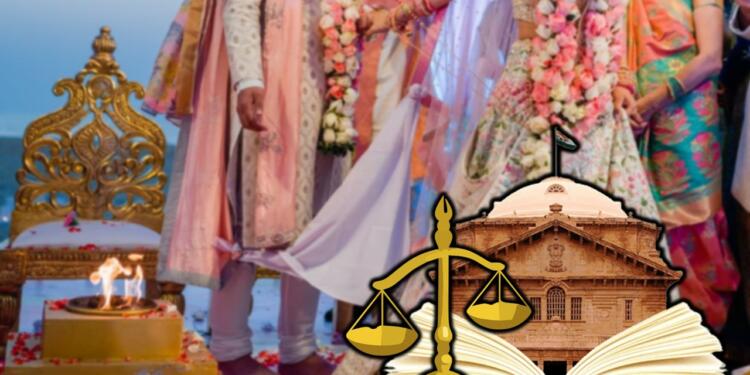Saptapadi ritual: In Sanatana Dharma, marriages go beyond contracts and showmanship. Recently, the Allahabad High Court took an important stance on this matter.
They emphasized that a Hindu marriage is not just about exchanging garlands and rings. It’s more profound. They explained that for a marriage to be valid and recognized by the law, it must follow proper ceremonies, especially the Saptapadi ritual.
The High Court’s ruling highlighted the significance of these rituals. Without them, a marriage cannot be considered “solemnized” or legally valid.
So, welcome everyone, and join us as we explore the wisdom of this judgment and the true essence of Hindu matrimony. We shall also know how in Sanatana Dharma, marriage is about adhering to ancient traditions, not some superficial show-off.
Saptapadi ceremony: The judgment not many expected
In a recent judgment that carries profound implications for Hindu marriages, the Allahabad High Court has spoken with unwavering authority and clarity. The case revolved around a marriage dispute, where a man sought to prove the invalidity of his estranged wife’s purported ‘second marriage.’ What emerged from this legal crucible was a resounding affirmation of the sanctity of Hindu matrimonial traditions.
The Allahabad High Court left no room for ambiguity. It unequivocally ruled that Hindu marriages are incomplete without the solemn and sacred ‘Saptapadi’ ceremony, also known as ‘saat phere’ in Hindi, wherein the bride and groom take seven rounds around the holy fire. This ancient ritual, the court asserted, is a fundamental pillar of a valid Hindu marriage.
Also read: Hindu Marriages hold the Key to unification of all Hindus, Fascinating isn’t it?
In its authoritative pronouncement, the court elucidated the very essence of the term ‘solemnize’ in the context of marriage. It emphasized that to ‘solemnize’ a marriage means to celebrate it with proper ceremonies and due form. Without these rituals performed in the prescribed manner, a marriage cannot be considered ‘solemnized’ under the law.
The court went further to assert that if a marriage does not conform to the legal requirements set forth by the law applicable to the parties involved, it is not a marriage in the eyes of the law. The absence of the ‘Saptapadi’ ceremony in the present case was a glaring deficiency that rendered the marriage invalid.
The Honb. High Court invoked Section 7 of the Hindu Marriage Act of 1955 to buttress its stance. This section unequivocally stipulates that customary rituals and ceremonies must be followed for the solemnization of a Hindu marriage. The bride and groom, during these rites, take seven sacred steps together around a consecrated fire. With the final step, the marriage is declared as final and binding.
In a country where numerous voices, including some judges, often assert their views on matters pertaining to Sanatan society, this judgment from the Allahabad High Court resonates like melodious music. It reaffirms the sanctity of time-honoured Hindu traditions, placing them firmly within the purview of the law. This decision serves as a beacon of clarity and wisdom in a complex legal landscape, reminding us of the enduring significance of our cultural heritage in the realm of matrimony.
Sanatan marriages are different
Marriages in Sanatan Dharma, let’s get this clear, aren’t just contracts, or elements of status symbols. They’re way more than that.
From a primal perspective, if we were to strip away civilization’s layers and view ourselves as animals, marriage becomes about procreation and the preservation of the genetic line. Yet, when we ascend to the realm of social consciousness, it transforms into something far more profound—an institution encompassing family, companionship, and unwavering emotional support.
The spectrum of motivations for marriage spans extremes. At one end lies the gold digger, driven solely by avarice and the pursuit of wealth. At the other, we find the hopelessly confused, entangled in a web of third, fourth, or even more marriages.
Also read: Allahabad HC rips into Adipurush makers, but doesn’t spare the Censor Board either
Now, let us juxtapose this complexity with the wisdom of our rishis, the ancient seers who advocated a dharma-centric approach. In their timeless wisdom, a wife was not just a spouse but a ‘Sahadharmini,’ a co-traveller on the path of dharma. However, as time flowed like a river, the purity of this wisdom got tainted, its brilliance dulled by the erosion of practice, comprehension, and even awareness..
In the teachings of Sanatan Dharma, they make it clear: things like desire, ego, envy, greed, and vanity have no place in marriage. Marriage is a holy bond where you let go of all these base desires. Vivaha, or marriage, in Sanatan Dharma is a dharmic journey. It’s about a couple evolving together while serving society selflessly.
If we imbibe and apply the spirit of this message from the rishis, then every marriage is bound to be successful, enrich the society and raise the standard for the future generations. It will be not an easy task given the fact that we have been intoxicated by the western model, despite seeing the disastrous consequences. However, with the right approach, this path doesn’t seem impossible to tread either.
Now, why’s this important? Because in today’s world, where ego, extreme activism, and cultural clashes often dominate, the recent judgment by the Allahabad High Court shines like a guiding light. It reminds us of the profound meaning of marriage in Sanatan Dharma, offering hope that amidst all the chaos, our ancient wisdom can still show us the path to a harmonious and righteous life.
Support TFI:
Support us to strengthen the ‘Right’ ideology of cultural nationalism by purchasing the best quality garments from TFI-STORE.COM.


































